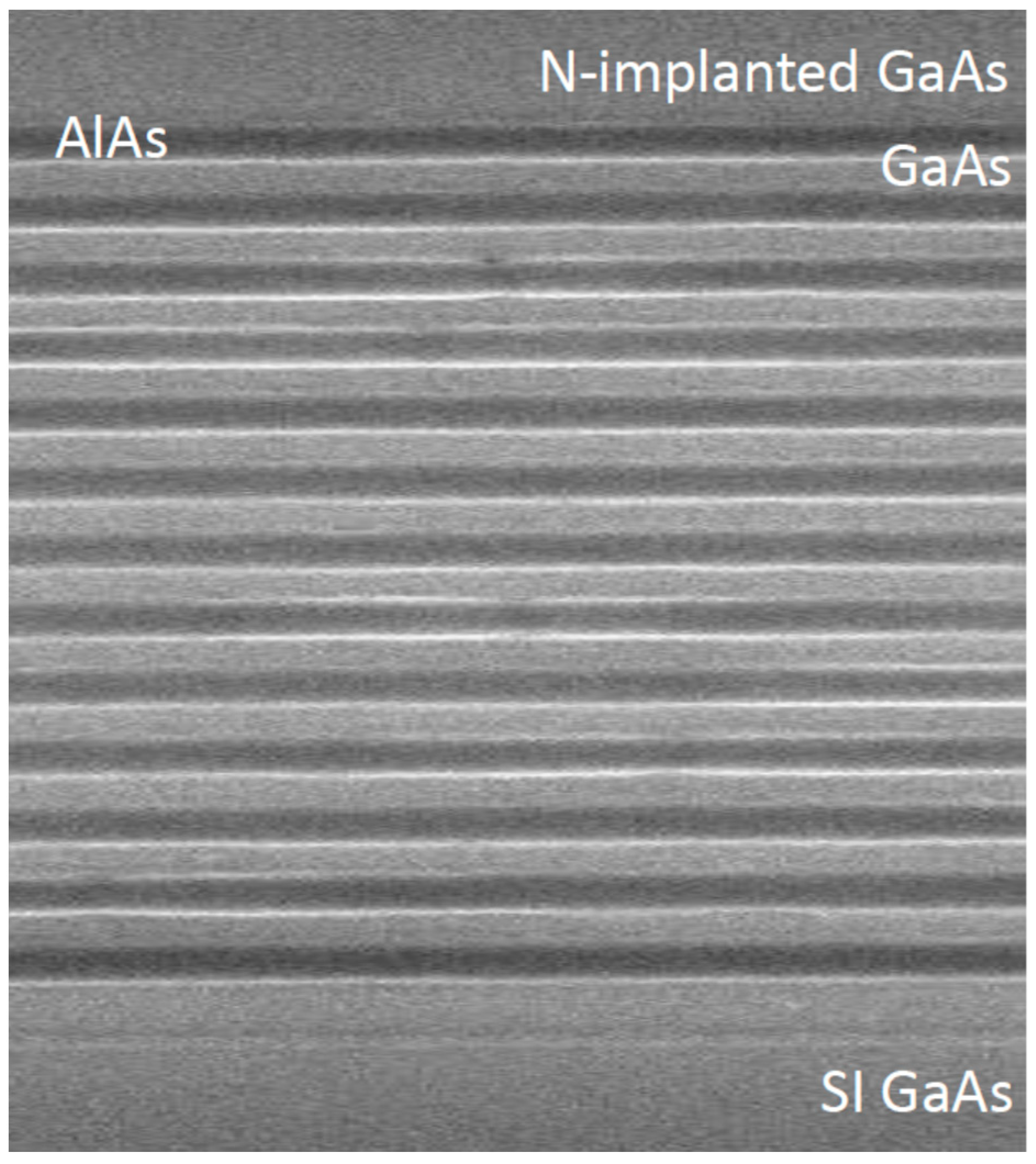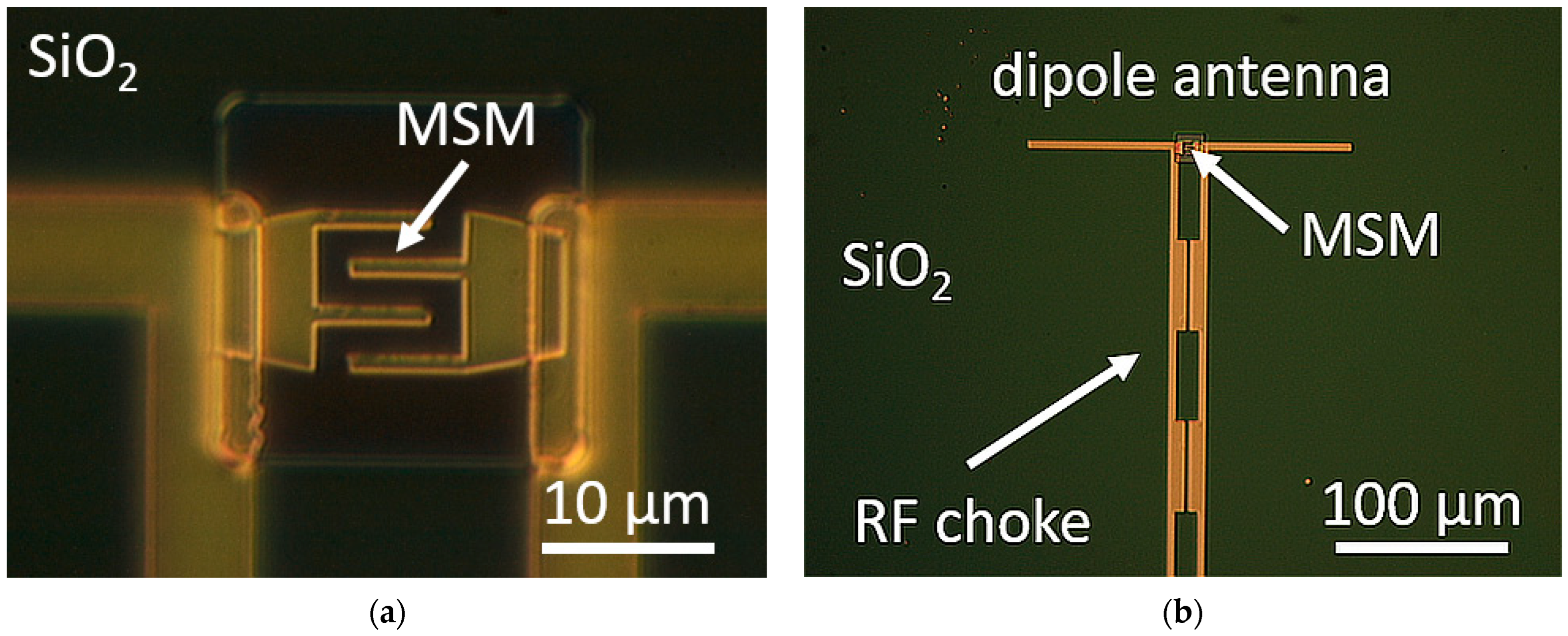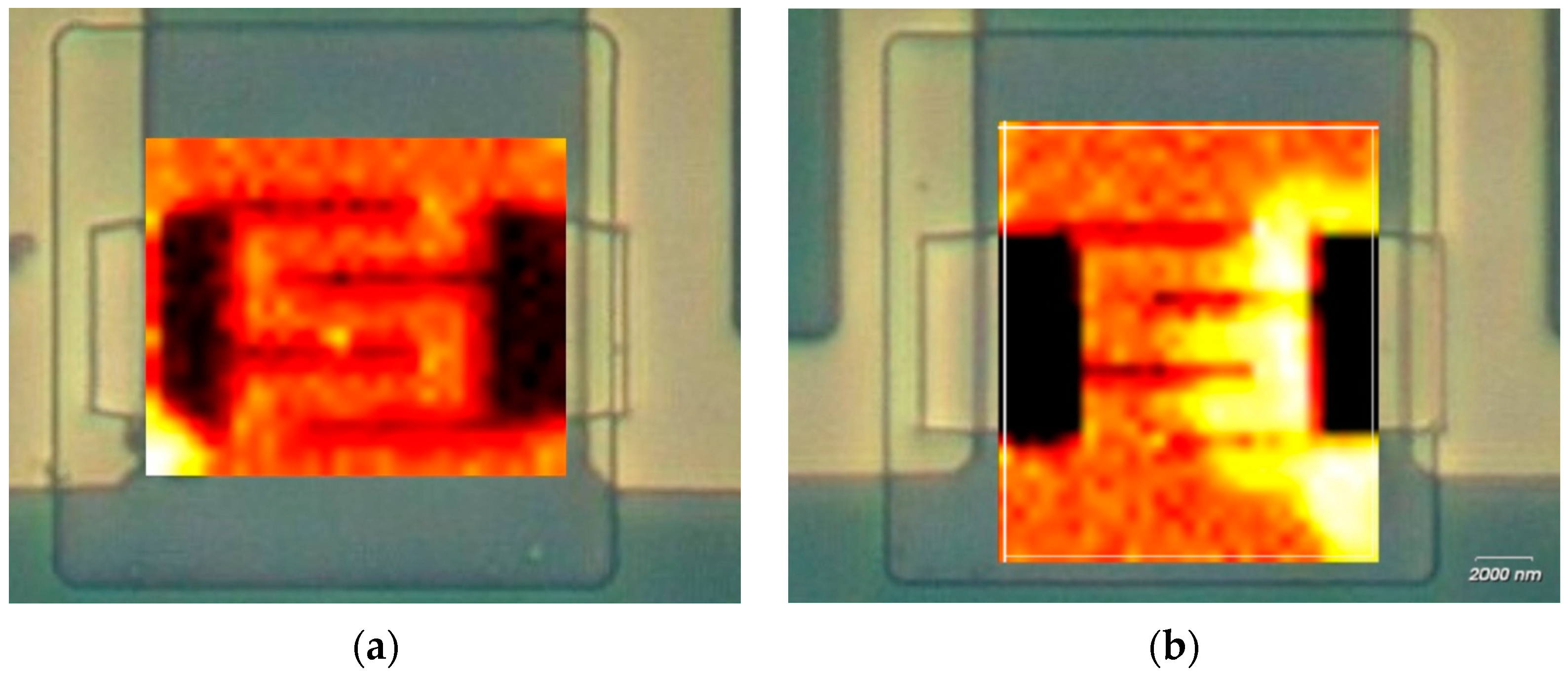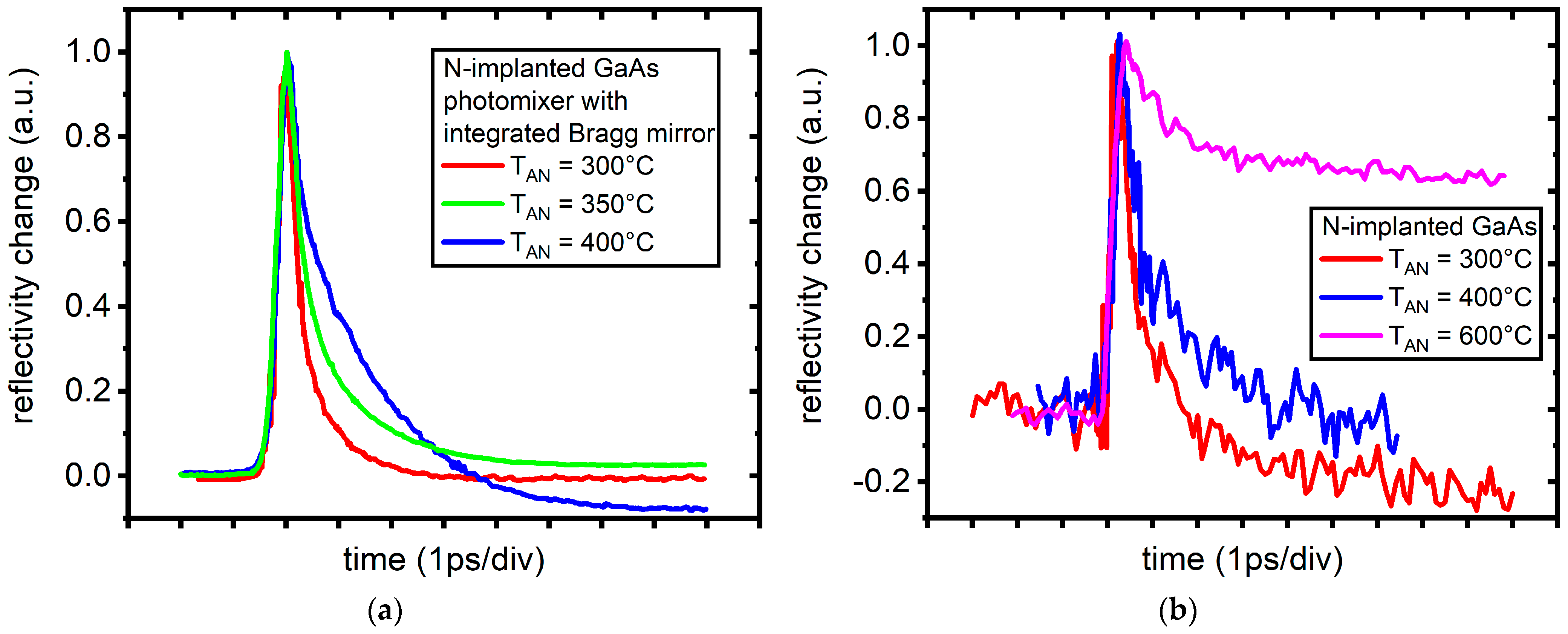Determination of Thermal Damage Threshold in THz Photomixers Using Raman Spectroscopy
Abstract
1. Introduction
2. Materials and Methods
3. Results
3.1. Raman Spectroscopy Investigations
3.2. Carrier Lifetime and Photomixer Characteristics
4. Discussion
5. Conclusions
Author Contributions
Funding
Data Availability Statement
Conflicts of Interest
References
- Liliental-Weber, Z.; Swider, W.; Yu, K.M.; Kortright, J.; Smith, F.W.; Calawa, A.R. Breakdown of crystallinity in low-temperature-grown GaAs layers. Appl. Phys. Lett. 1991, 58, 2153–2155. [Google Scholar] [CrossRef]
- Look, D.C. Molecular beam epitaxial GaAs grown at low temperatures. Thin Solid Films 1993, 231, 61–73. [Google Scholar] [CrossRef]
- Brown, E.R.; McIntosh, K.A.; Nichols, K.B.; Dennis, C.L. Photomixing up to 3.8 THz in low-temperature-grown GaAs. Appl. Phys. Lett. 1995, 66, 285–287. [Google Scholar] [CrossRef]
- McIntosh, K.A.; Brown, E.R.; Nichols, K.B.; McMahon, O.B.; DiNatale, W.F.; Lyszczarz, T.M. Terahertz photomixing with diode lasers in low-temperature-grown GaAs. Appl. Phys. Lett. 1995, 67, 3844–3846. [Google Scholar] [CrossRef]
- Matsuura, S.; Tani, M.; Sakai, K. Generation of coherent terahertz radiation by photomixing in dipole photoconductive antennas. Appl. Phys. Lett. 1997, 70, 559–561. [Google Scholar] [CrossRef]
- Kordoš, P.; Förster, A.; Marso, M.; Rüders, F. 550 GHz bandwidth photodetector on low-temperature grown molecular-beam epitaxial GaAs. Electron. Lett. 1998, 34, 119–120. [Google Scholar] [CrossRef]
- Shan, W.; Yu, K.M.; Walukiewicz, W.; Ager, J.W.; Haller, E.E.; Ridgway, M.C. Reduction of band-gap energy in GaNAs and AlGaNAs synthesized by N+ implantation. Appl. Phys. Lett. 1999, 75, 1410–1412. [Google Scholar] [CrossRef]
- Matsuura, S.; Blake, G.A.; Wyss, R.A.; Pearson, J.C.; Kadow, C.; Jackson, A.W.; Gossard, A.C. Design and characterization of optical-THz phase-matched traveling-wave photomixers. In Proceedings of the SPIE’s International Symposium on Optical Science, Engineering, and Instrumentation, Denver, CO, USA, 12 November 1999; Hwu, R.J., Wu, K., Eds.; Terahertz Gigahertz Photonics. Society of Photo-Optical Instrumentation Engineers (SPIE): Bellingham, WA, USA, 1999; p. 484. [Google Scholar] [CrossRef]
- Siebert, K.; Siebe, F.; Roskos, H.; Leonhardt, R. A two-color Ti:sapphire laser for CW-THz generation. In Proceedings of the Conference on Lasers and Electro-Optics (CLEO 2000), Technical Digest; Postconference Edition; TOPS Vol.39 (IEEE Cat. No.00CH37088), San Francisco, CA, USA, 7–12 May 2000; p. 497. [Google Scholar] [CrossRef]
- Stöhr, A.; Heinzelmann, R.; Hagedorn, K.; Güsten, R.; Schäfer, F.; Stüer, H.; Siebe, F.; van der Wal, P.; Krozer, V.; Feiginov, M.; et al. Integrated 460 GHz photonic transmitter module. Electron. Lett. 2001, 37, 1347–1348. [Google Scholar] [CrossRef]
- Yu, K.M.; Walukiewicz, W.; Wu, J.; Beeman, J.W.; Ager, J.W.; Haller, E.E.; Shan, W.; Xin, H.P.; Tu, C.W.; Ridgway, M.C. Formation of diluted III–V nitride thin films by N ion implantation. J. Appl. Phys. 2001, 90, 2227–2234. [Google Scholar] [CrossRef]
- Mikulics, M.; Siebe, F.; Fox, A.; Marso, M.; Forster, A.; Stuer, H.; Schafer, F.; Gusten, R.; Kordos, P. Generation of 460 GHz radiation by photomixing in low-temperature-grown MBE GaAs. In Proceedings of the Fourth International Conference on Advanced Semiconductor Devices and Microsystem, Smolenice, Slovakia, 16 October 2003. [Google Scholar] [CrossRef]
- Peytavit, E.; Arscott, S.; Lippens, D.; Mouret, G.; Matton, S.; Masselin, P.; Bocquet, R.; Lampin, J.F.; Desplanque, L.; Mollot, F. Terahertz frequency difference from vertically integrated low-temperature-grown GaAs photodetector. Appl. Phys. Lett. 2002, 81, 1174–1176. [Google Scholar] [CrossRef]
- Wu, J.; Shan, W.; Walukiewicz, W. Band anticrossing in highly mismatched III V semiconductor alloys. Semicond. Sci. Technol. 2002, 17, 860–869. [Google Scholar] [CrossRef]
- Mikulics, M.; Marso, M.; Kordoš, P.; Stanček, S.; Kováč, P.; Zheng, X.; Wu, S.; Sobolewski, R. Ultrafast and highly sensitive photodetectors fabricated on high-energy nitrogen-implanted GaAs. Appl. Phys. Lett. 2003, 83, 1719–1721. [Google Scholar] [CrossRef][Green Version]
- Sinning, S.; Dekorsy, T.; Helm, M. Ultrafast carrier dynamics in nitrogen-implanted GaAs. IEE Proc. Optoelectron. 2004, 151, 361–364. [Google Scholar] [CrossRef]
- Krotkus, A.; Coutaz, J.-L. Non-stoichiometric semiconductor materials for terahertz optoelectronics applications. Semicond. Sci. Technol. 2005, 20, S142–S150. [Google Scholar] [CrossRef]
- Döhler, G.H.; Renner, F.; Klar, O.; Eckardt, M.; Schwanhäußer, A.; Malzer, S.; Driscoll, D.; Hanson, M.; Gossard, A.C.; Loata, G.; et al. THz-photomixer based on quasi-ballistic transport. Semicond. Sci. Technol. 2005, 20, S178–S190. [Google Scholar] [CrossRef]
- Mikulics, M.; Marso, M.; Mayorga, I.C.; Güsten, R.; Stanček, S.; Kováč, P.; Wu, S.; Li, X.; Khafizov, M.; Sobolewski, R.; et al. Photomixers fabricated on nitrogen-ion-implanted GaAs. Appl. Phys. Lett. 2005, 87, 041106. [Google Scholar] [CrossRef]
- Suzuki, M.; Tonouchi, M. Fe-implanted InGaAs photoconductive terahertz detectors triggered by 1.56μm femtosecond optical pulses. Appl. Phys. Lett. 2005, 86, 163504. [Google Scholar] [CrossRef]
- Salem, B.; Morris, D.; Aimez, V.; Beerens, J.; Beauvais, J.; Houde, D. Pulsed photoconductive antenna terahertz sources made on ion-implanted GaAs substrates. J. Physics Condens. Matter 2005, 17, 7327–7333. [Google Scholar] [CrossRef]
- Chimot, N.; Mangeney, J.; Joulaud, L.; Crozat, P.; Bernas, H.; Blary, K.; Lampin, J.F. Terahertz radiation from heavy-ion-irradiated In0.53Ga0.47As photoconductive antenna excited at 1.55 μm. Appl. Phys. Lett. 2005, 87, 193510. [Google Scholar] [CrossRef]
- Mikulics, M.; Wu, S.; Marso, M.; Adam, R.; Forster, A.; van der Hart, A.; Kordos, P.; Luth, H.; Sobolewski, R. Ultrafast and highly sensitive photodetectors with recessed electrodes fabricated on low-temperature-grown GaAs. IEEE Photon. Technol. Lett. 2006, 18, 820–822. [Google Scholar] [CrossRef]
- Mikulics, M.; Michael, E.A.; Schieder, R.; Stutzki, J.; Güsten, R.; Marso, M.; van der Hart, A.; Bochem, H.P.; Lüth, H.; Kordoš, P. Traveling-wave photomixer with recessed interdigitated contacts on low-temperature-grown GaAs. Appl. Phys. Lett. 2006, 88, 041118. [Google Scholar] [CrossRef]
- Salem, B.; Morris, D.; Aimez, V.; Beauvais, J.; Houde, D. Improved characteristics of a terahertz set-up built with an emitter and a detector made on proton-bombarded GaAs photoconductive materials. Semicond. Sci. Technol. 2006, 21, 283–286. [Google Scholar] [CrossRef][Green Version]
- Mikulics, M.; Michael, E.A.; Marso, M.; Lepsa, M.; van der Hart, A.; Lüth, H.; Dewald, A.; Stanček, S.; Mozolik, M.; Kordoš, P. Traveling-wave photomixers fabricated on high energy nitrogen-ion-implanted GaAs. Appl. Phys. Lett. 2006, 89, 071103. [Google Scholar] [CrossRef]
- Sartorius, B.; Roehle, H.; Künzel, H.; Böttcher, J.; Schlak, M.; Stanze, D.; Venghaus, H.; Schell, M. All-fiber terahertz time-domain spectrometer operating at 1.5 μm telecom wavelengths. Opt. Express 2008, 16, 9565–9570. [Google Scholar] [CrossRef]
- Ospald, F.; Maryenko, D.; von Klitzing, K.; Driscoll, D.C.; Hanson, M.P.; Lu, H.; Gossard, A.C.; Smet, J.H. 1.55 μm ultrafast photoconductive switches based on ErAs: InGaAs. Appl. Phys. Lett. 2008, 92, 131117. [Google Scholar] [CrossRef]
- Mikulics, M.; Marso, M.; Wu, S.; Fox, A.; Lepsa, M.; Grutzmacher, D.; Sobolewski, R.; Kordos, P. Sensitivity Enhancement of Metal– Semiconductor –Metal Photodetectors on Low-Temperature-Grown GaAs Using Alloyed Contacts. IEEE Photonics Technol. Lett. 2008, 20, 1054–1056. [Google Scholar] [CrossRef]
- Peytavit, E.; Lampin, J.-F.; Hindle, F.; Yang, C.; Mouret, G. Wide-band continuous-wave terahertz source with a vertically integrated photomixer. Appl. Phys. Lett. 2009, 95, 161102. [Google Scholar] [CrossRef]
- Plinski, E. Terahertz photomixer. Bull. Pol. Acad. Sci. Tech. Sci. 2010, 58, 463–470. [Google Scholar] [CrossRef]
- Hofmann, M.R.; Scheller, M.; Brenner, C.; Baaske, K.; Koch, M. Cost-effective THz spectroscopy with continuous-wave laser sources. In Proceedings of the EuCAP 2010—4th European Conference on Antennas and Propagation, Barcelona, Spain, 12–16 April 2010; pp. 1–4. [Google Scholar]
- Pačebutas, V.; Bičiūnas, A.; Balakauskas, S.; Krotkus, A.; Andriukaitis, G.; Lorenc, D.; Pugžlys, A.; Baltuška, A. Terahertz time-domain-spectroscopy system based on femtosecond Yb:fiber laser and GaBiAs photoconducting components. Appl. Phys. Lett. 2010, 97, 031111. [Google Scholar] [CrossRef]
- Preu, S.; Döhler, G.H.; Malzer, S.; Wang, L.J.; Gossard, A.C. Tunable, continuous-wave Terahertz photomixer sources and applications. J. Appl. Phys. 2011, 109, 061301. [Google Scholar] [CrossRef]
- Brenner, C.; Friedrich, C.-S.; Hofmann, M.R. Semiconductor Diode Lasers for Terahertz Technology. J. Infrared. Millimeter. Terahertz Waves 2011, 32, 1253–1266. [Google Scholar] [CrossRef]
- Xu, M.; Mittendorff, M.; Dietz, R.J.B.; Künzel, H.; Sartorius, B.; Göbel, T.; Schneider, H.; Helm, M.; Winnerl, S. Terahertz generation and detection with InGaAs-based large-area photoconductive devices excited at 1.55 μm. Appl. Phys. Lett. 2013, 103, 251114. [Google Scholar] [CrossRef]
- Koenig, S.; Lopez-Diaz, D.; Antes, J.; Boes, F.; Henneberger, R.; Leuther, A.; Tessmann, A.; Schmogrow, R.; Hillerkuss, D.; Palmer, R.; et al. Wireless sub-THz communication system with high data rate. Nat. Photonics 2013, 7, 977–981. [Google Scholar] [CrossRef]
- Deninger, A. State-of-the-art in terahertz continuous-wave photomixer systems. In Handbook of Terahertz Technology for Imaging, Sensing and Communications; Elsevier: Amsterdam, The Netherlands, 2013; pp. 327–373. [Google Scholar] [CrossRef]
- Peytavit, E.; Pavanello, F.; Ducournau, G.; Lampin, J.-F. Highly efficient terahertz detection by optical mixing in a Fabry-Perot cavity LT-GaAs photoconductor. In Proceedings of the 2014 39th International Conference on Infrared, Millimeter, and Terahertz Waves (IRMMW-THz), Tucson, AZ, USA, 14–19 September 2014; pp. 1–2. [Google Scholar] [CrossRef]
- Ríos, R.D.V.; Bikorimana, S.; Ummy, M.A.; Dorsinville, R.; Seo, S.-W. A bow-tie photoconductive antenna using a low-temperature-grown GaAs thin-film on a silicon substrate for terahertz wave generation and detection. J. Opt. 2015, 17, 125802. [Google Scholar] [CrossRef]
- Nagatsuma, T.; Ducournau, G.; Renaud, C.C. Advances in terahertz communications accelerated by photonics. Nat. Photonics 2016, 10, 371–379. [Google Scholar] [CrossRef]
- Currie, M. Low-temperature grown Gallium Arsenide (LT-GaAs) high-speed detectors. In Photodetectors; Elsevier: Amsterdam, The Netherlands, 2016; pp. 121–155. [Google Scholar] [CrossRef]
- Burford, N.M.; El-Shenawee, M.O. Review of terahertz photoconductive antenna technology. Opt. Eng. 2017, 56, 010901. [Google Scholar] [CrossRef]
- Kohlhaas, R.B.; Dietz, R.J.B.; Breuer, S.; Nellen, S.; Liebermeister, L.; Schell, M.; Globisch, B. Improving the dynamic range of InGaAs-based THz detectors by localized beryllium doping: Up to 70 dB at 3 THz. Opt. Lett. 2018, 43, 5423–5426. [Google Scholar] [CrossRef] [PubMed]
- Ponomarev, D.; Lavrukhin, D.; Yachmenev, A.; Khabibullin, R.; Semenikhin, I.; Vyurkov, V.; Ryzhii, M.; Otsuji, T.; Ryzhii, V. Sn-nanothreads in GaAs matrix and their sub- and terahertz applications. J. Phys. Conf. Ser. 2018, 1092, 012166. [Google Scholar] [CrossRef]
- Safian, R.; Ghazi, G.; Mohammadian, N. Review of photomixing continuous-wave terahertz systems and current application trends in terahertz domain. Opt. Eng. 2019, 58, 110901. [Google Scholar] [CrossRef]
- Che, M.; Matsuo, Y.; Kanaya, H.; Ito, H.; Ishibashi, T.; Kato, K. Optoelectronic THz-Wave Beam Steering by Arrayed Photomixers with Integrated Antennas. IEEE Photonics Technol. Lett. 2020, 32, 979–982. [Google Scholar] [CrossRef]
- Xie, J.; Ye, W.; Zhou, L.; Guo, X.; Zang, X.; Chen, L.; Zhu, Y. A Review on Terahertz Technologies Accelerated by Silicon Photonics. Nanomaterials 2021, 11, 1646. [Google Scholar] [CrossRef] [PubMed]
- Che, M.; Kondo, K.; Kanaya, H.; Kato, K. Arrayed Photomixers for THz Beam-Combining and Beam-Steering. J. Light. Technol. 2022, 40, 6657–6665. [Google Scholar] [CrossRef]
- Hollfelder, M.; Hardtdegen, H.; Meyer, R.; Carius, R.; Lüth, H. (AlGa)As grown by low pressure metalorganic vapor phase epitaxy using a N2 carrier. J. Electron. Mater. 1994, 23, 1061–1065. [Google Scholar] [CrossRef]
- Hardtdegen, H.; Ungermanns, C.; Hollfelder, M.; Raafat, T.; Carius, R.; Hasenöhrl, S.; Lüth, H. A new approach towards low-pressure metalorganic vapor phase epitaxy of (AlGa)As using triethylgallium and dimethylethylaminealane. J. Cryst. Growth 1994, 145, 478–484. [Google Scholar] [CrossRef]
- Chen, G.; Chakraborty, D.; Cheng, J.; Mikulics, M.; Komissarov, I.; Adam, R.; Bürgler, D.E.; Schneider, C.M.; Hardtdegen, H.; Sobolewski, R. Transient THz Emission and Effective Mass Determination in Highly Resistive GaAs Crystals Excited by Femtosecond Optical Pulses. Crystals 2022, 12, 1635. [Google Scholar] [CrossRef]
- Mikulics, M.; Lu, J.; Huang, L.; Tse, P.; Zhang, J.; Mayer, J.; Hardtdegen, H. Laser micro annealing conditioning for the suppression of statistical scatter in freestanding Sb2Te3 nanowire resistance. Flatchem 2020, 21, 100164. [Google Scholar] [CrossRef]
- Wagner, J.; Hoffman, C. Resonant two-phonon Raman scattering in GaAs: A sensitive probe for implantation damage and annealing. Appl. Phys. Lett. 1987, 50, 682–684. [Google Scholar] [CrossRef]
- Fleischer, S.; Beling, C.D.; Fung, S.; Nieveen, W.R.; Squire, J.E.; Zheng, J.Q.; Missous, M. Structural and defect characterization of GaAs and AlxGa1−xAs grown at low temperature by molecular beam epitaxy. J. Appl. Phys. 1997, 81, 190–198. [Google Scholar] [CrossRef]
- Jiang, D.-S.; Li, X.-P.; Sun, B.-Q.; Han, H.-X. A Raman scattering study of GaAs: As films lifted off GaAs substrate. J. Phys. D Appl. Phys. 1999, 32, 629–631. [Google Scholar] [CrossRef]
- Yazji, S.; Zardo, I.; Soini, M.; Postorino, P.; Morral, A.F.i.; Abstreiter, G. Local modification of GaAs nanowires induced by laser heating. Nanotechnology 2011, 22, 325701. [Google Scholar] [CrossRef]
- McDevitt, N.T.; Baun, W.L.; Solomon, J.S. Characterization of Thermally Treated Gallium Arsenide by Laser-Raman and Auger Spectroscopy. 1984. Available online: https://apps.dtic.mil/sti/tr/pdf/ADA148414.pdf (accessed on 8 August 2023).
- McDevitt, N.T.; Solomon, J.S. Thermal Oxide Layers on GaAs Studied by Raman and Auger Spectroscopy. J. Electrochem. Soc. 1986, 133, 1913–1917. [Google Scholar] [CrossRef]
- Garg, A.; Kapoor, A.; Tripathi, K. Laser-induced damage studies in GaAs. Opt. Laser Technol. 2003, 35, 21–24. [Google Scholar] [CrossRef]
- Pimenta, A.C.S.; Limborço, H.; González, J.C.; Cifuentes, N.; Ramos, S.L.L.M.; Matinaga, F.M. Photodegradation of Si-doped GaAs nanowire. RSC Adv. 2019, 9, 39488–39494. [Google Scholar] [CrossRef] [PubMed]
- Pizani, P.S.; Campos, C.E.M. Raman probing of thermal damage depth profile in annealed GaAs. J. Appl. Phys. 1998, 84, 6588–6591. [Google Scholar] [CrossRef]
- Shockley, W.; Read, W.T. Statistics of the Recombinations of Holes and Electrons. Phys. Rev. 1952, 87, 835–842. [Google Scholar] [CrossRef]
- Mikulics, M.; Marso, M.; Mantl, S.; Lüth, H.; Kordoš, P. GaAs photodetectors prepared by high-energy and high-dose nitrogen implantation. Appl. Phys. Lett. 2006, 89, 091103. [Google Scholar] [CrossRef]
- Chen, G.; Mikulics, M.; Adam, R.; Pericolo, A.; Serafini, J.; Preble, S.; Cheng, J.; Chimera, C.; Komissarov, I.; Hardtdegen, H.H.; et al. Photomixing THz Generation from Nitrogen-Ion–Implanted GaAs Metal-Semiconductor-Metal Diodes Enhanced by a Bragg Mirror. In Proceedings of the 2020 45th International Conference on Infrared, Millimeter, and Terahertz Waves (IRMMW-THz), Buffalo, NY, USA, 8–13 November 2020; pp. 1–2. [Google Scholar] [CrossRef]
- Mikulics, M. Preparation and Optimization of Low-Temperature Grown GaAs Photomixers. Ph.D. Thesis, RWTH Aachen, Aachen, Germany, 2005. [Google Scholar]
- Menéndez, J.; Cardona, M. Temperature dependence of the first-order Raman scattering by phonons in Si, Ge, andα−Sn: Anharmonic effects. Phys. Rev. B 1984, 29, 2051–2059. [Google Scholar] [CrossRef]
- Ardila, A.M.; Martínez, O.; Avella, M.; Jiménez, J.; Gérard, B.; Napierala, J.; Gil-Lafon, E. Temperature dependence of the Raman shift in GaAs conformal layers grown by hydride vapor phase epitaxy. J. Appl. Phys. 2002, 91, 5045–5050. [Google Scholar] [CrossRef]






Disclaimer/Publisher’s Note: The statements, opinions and data contained in all publications are solely those of the individual author(s) and contributor(s) and not of MDPI and/or the editor(s). MDPI and/or the editor(s) disclaim responsibility for any injury to people or property resulting from any ideas, methods, instructions or products referred to in the content. |
© 2023 by the authors. Licensee MDPI, Basel, Switzerland. This article is an open access article distributed under the terms and conditions of the Creative Commons Attribution (CC BY) license (https://creativecommons.org/licenses/by/4.0/).
Share and Cite
Mikulics, M.; Adam, R.; Chen, G.; Chakraborty, D.; Cheng, J.; Pericolo, A.; Komissarov, I.; Bürgler, D.E.; Heidtfeld, S.F.; Serafini, J.; et al. Determination of Thermal Damage Threshold in THz Photomixers Using Raman Spectroscopy. Crystals 2023, 13, 1267. https://doi.org/10.3390/cryst13081267
Mikulics M, Adam R, Chen G, Chakraborty D, Cheng J, Pericolo A, Komissarov I, Bürgler DE, Heidtfeld SF, Serafini J, et al. Determination of Thermal Damage Threshold in THz Photomixers Using Raman Spectroscopy. Crystals. 2023; 13(8):1267. https://doi.org/10.3390/cryst13081267
Chicago/Turabian StyleMikulics, Martin, Roman Adam, Genyu Chen, Debamitra Chakraborty, Jing Cheng, Anthony Pericolo, Ivan Komissarov, Daniel E. Bürgler, Sarah F. Heidtfeld, John Serafini, and et al. 2023. "Determination of Thermal Damage Threshold in THz Photomixers Using Raman Spectroscopy" Crystals 13, no. 8: 1267. https://doi.org/10.3390/cryst13081267
APA StyleMikulics, M., Adam, R., Chen, G., Chakraborty, D., Cheng, J., Pericolo, A., Komissarov, I., Bürgler, D. E., Heidtfeld, S. F., Serafini, J., Preble, S., Sobolewski, R., Schneider, C. M., Mayer, J., & Hardtdegen, H. H. (2023). Determination of Thermal Damage Threshold in THz Photomixers Using Raman Spectroscopy. Crystals, 13(8), 1267. https://doi.org/10.3390/cryst13081267






